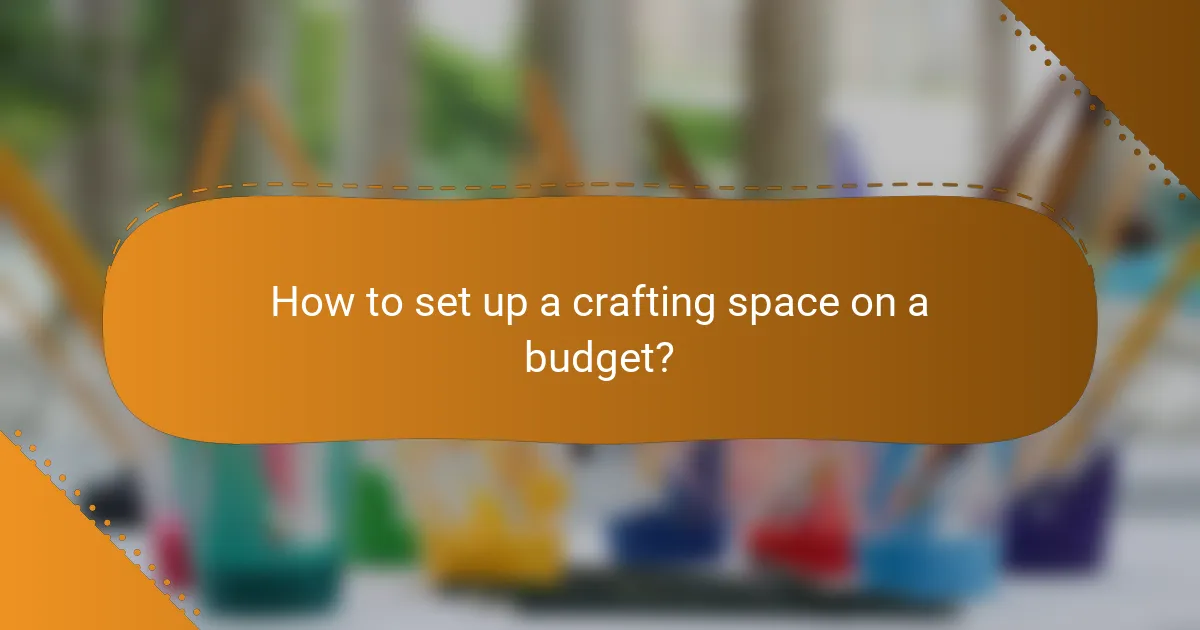Creating your first crafting space on a budget can be both rewarding and fun. By creatively repurposing items and prioritizing essential tools, you can establish an efficient workspace that inspires your creativity. Organizing your supplies by type and usage will enhance accessibility and streamline your projects, making the most of your crafting experience without breaking the bank.

How to set up a crafting space on a budget?
Setting up a crafting space on a budget involves creatively utilizing available resources while prioritizing essential tools and materials. Focus on repurposing items, shopping smartly, and implementing cost-effective storage solutions to create an efficient workspace without overspending.
Use repurposed furniture
Repurposing furniture is an excellent way to save money while creating a functional crafting area. Look around your home for unused tables, shelves, or cabinets that can be transformed into crafting stations. A sturdy dining table can serve as a workspace, while old bookshelves can be used for storing supplies.
Consider giving new life to these items with a fresh coat of paint or by adding new hardware. This not only enhances their appearance but also personalizes your crafting space. Ensure that the furniture you choose is durable and can withstand the wear and tear of crafting activities.
Shop at thrift stores
Thrift stores are treasure troves for budget-conscious crafters. You can find a variety of items, from furniture to crafting supplies, often at a fraction of the retail price. Regular visits can yield great finds, such as fabric, tools, or storage containers that fit your needs.
When shopping, keep an open mind and be willing to get creative with your purchases. An old dresser can become a storage unit for craft materials, while picture frames can be repurposed for organizing tools. Always check for quality and functionality to ensure your purchases are worthwhile.
DIY storage solutions
Creating your own storage solutions can significantly reduce costs while maximizing space in your crafting area. Simple projects like building shelving units or using mason jars for small items can keep your supplies organized and accessible. Consider using pegboards to hang tools and materials, which saves space and keeps everything visible.
Utilize clear bins or boxes to categorize supplies, labeling each container for easy identification. This not only helps maintain order but also makes it easier to find what you need quickly. Remember to measure your space before starting any DIY project to ensure your solutions fit perfectly.

What are the essential tools for a crafting space?
The essential tools for a crafting space vary based on the type of crafts you pursue, but some basics are universally important. These tools help streamline your projects and enhance your creativity, making it easier to bring your ideas to life.
Basic crafting tools
Basic crafting tools include items like scissors, glue, cutting mats, and rulers. These tools are fundamental for a variety of projects, whether you’re working with paper, fabric, or other materials. Investing in quality versions of these tools can improve your efficiency and the overall outcome of your crafts.
Consider organizing these tools in a dedicated caddy or drawer to keep them accessible. A well-organized space reduces frustration and saves time when you need to find a specific item quickly. Regularly check your supplies to ensure everything is in good condition and replace any worn-out items.
Specialized equipment for specific crafts
Depending on your crafting focus, you may require specialized equipment. For example, a sewing machine is essential for fabric crafts, while a Cricut machine is popular for paper crafting and vinyl projects. These tools can significantly expand your capabilities and allow for more intricate designs.
When selecting specialized equipment, consider your budget and the frequency of use. Some tools can be quite an investment, so it’s wise to start with the essentials and gradually add to your collection as your skills develop. Look for second-hand options or local crafting groups that may offer equipment rentals to save costs.

How to organize your crafting supplies effectively?
To organize your crafting supplies effectively, start by categorizing items based on their type and frequency of use. This approach not only enhances accessibility but also maximizes your workspace efficiency.
Labeling systems
Implementing a labeling system is crucial for quick identification of your crafting supplies. Use clear, legible labels on containers and shelves to indicate contents, categories, or project types. Consider color-coding labels for different crafting categories, such as sewing, painting, or scrapbooking, to streamline your workflow.
Choose durable labels that can withstand wear and tear, especially if you frequently access your supplies. You can use a label maker for a professional look or simply write on adhesive labels for a more personal touch.
Storage containers and shelving
Selecting the right storage containers and shelving is essential for maintaining an organized crafting space. Opt for clear bins to easily see contents or stackable containers to save space. Use a mix of sizes to accommodate various items, from small tools to larger materials.
Wall-mounted shelves can be a great solution for maximizing vertical space, while drawer units can keep smaller items neatly tucked away. Ensure that the storage solutions you choose fit within your budget, with options available in a range from low-cost plastic bins to more expensive wooden organizers.

What are the best materials for crafting?
The best materials for crafting depend on the type of projects you plan to undertake. Common options include paper, fabric, wood, and various adhesives, each suited for different crafts like scrapbooking, sewing, or woodworking.
Budget-friendly crafting materials
To keep costs low, consider using recycled or repurposed materials. Items like cardboard boxes, old magazines, and fabric scraps can be transformed into unique creations without breaking the bank.
Look for sales at local craft stores or online retailers. Many stores offer discounts on bulk purchases, which can significantly reduce your overall spending. Dollar stores often carry basic supplies like glue, scissors, and paint at very low prices.
Quality brands for essential supplies
When investing in crafting materials, prioritize quality brands that are known for their durability and performance. For paper crafts, brands like Cricut and Canon are popular for their reliable cutting machines and quality papers.
For fabric, consider brands like Moda Fabrics or Robert Kaufman, which offer a wide range of high-quality cottons. For adhesives, Aleene’s and E6000 are trusted choices that provide strong bonds for various materials.

How to create a functional crafting layout?
To create a functional crafting layout, prioritize organization and accessibility. A well-planned space allows for efficient workflow and easy access to materials, enhancing your crafting experience.
Workstation design principles
When designing your crafting workstation, consider the flow of your projects. Arrange tools and materials in a way that minimizes movement; frequently used items should be within arm’s reach. For example, keep scissors, glue, and markers on the same surface to streamline your process.
Utilize vertical space with shelves or pegboards to store supplies. This not only keeps your workspace tidy but also maximizes the area you have. A clutter-free environment can significantly boost creativity and productivity.
Ergonomic considerations for crafters
Ergonomics play a crucial role in crafting comfort and efficiency. Ensure your workstation is at a comfortable height to prevent strain; ideally, your elbows should be at a 90-degree angle when working. If standing, consider anti-fatigue mats to reduce discomfort during long crafting sessions.
Invest in supportive seating if you work from a chair. Look for chairs with adjustable height and lumbar support to maintain good posture. Regular breaks and stretching can also help alleviate tension and keep you focused on your projects.

What are common mistakes to avoid in crafting space setup?
Common mistakes in crafting space setup include overcrowding the workspace and neglecting proper lighting and ventilation. These issues can hinder creativity and productivity, making it essential to address them during the setup process.
Overcrowding the workspace
Overcrowding can make it difficult to work efficiently and safely. When too many tools and materials are crammed into a small area, it leads to clutter, which can stifle creativity and increase the risk of accidents.
To avoid overcrowding, designate specific zones for different activities and keep only the essentials within arm’s reach. Consider using storage solutions like shelves, bins, or carts to organize materials and tools, ensuring that your workspace remains functional and inviting.
Neglecting lighting and ventilation
Good lighting and ventilation are crucial for a comfortable crafting environment. Poor lighting can strain your eyes and make it hard to see details, while inadequate ventilation can lead to unpleasant odors and unhealthy air quality, especially when working with paints or adhesives.
Incorporate natural light whenever possible and supplement with bright, adjustable task lighting. Ensure your crafting space is well-ventilated by opening windows or using fans, particularly when using materials that emit fumes. This will create a more pleasant and productive atmosphere for your crafting activities.

How to maintain your crafting space over time?
Maintaining your crafting space involves regular organization, cleaning, and reassessment of your supplies and tools. By establishing a routine, you can ensure that your area remains functional and inspiring for your creative projects.
Regular Cleaning and Decluttering
Set a schedule for cleaning and decluttering your crafting space, ideally once a month. During this time, sort through your materials and tools, removing anything that is broken, unused, or no longer inspires you. This helps keep your workspace organized and makes it easier to find what you need.
Consider using storage bins or containers to categorize supplies, making it easier to maintain order. Labeling these containers can save time and reduce frustration when searching for specific items.
Reassess Your Supplies and Tools
Every few months, take stock of your crafting supplies and tools. Assess what you use frequently and what has been sitting unused. This practice allows you to adjust your inventory according to your current projects and interests, ensuring that your space is tailored to your needs.
If you find items you no longer need, consider donating them to local schools, community centers, or crafting groups. This not only helps others but also frees up space in your crafting area.
Establish a Routine
Creating a routine for maintaining your crafting space can significantly improve its functionality. Set aside time each week to tidy up, put away supplies, and prepare for upcoming projects. A consistent routine can prevent clutter from accumulating and keep your creative environment inviting.
Incorporate small habits, like cleaning your workspace after each project, to make maintenance feel less overwhelming. This way, your crafting space remains a source of joy and inspiration rather than a source of stress.

